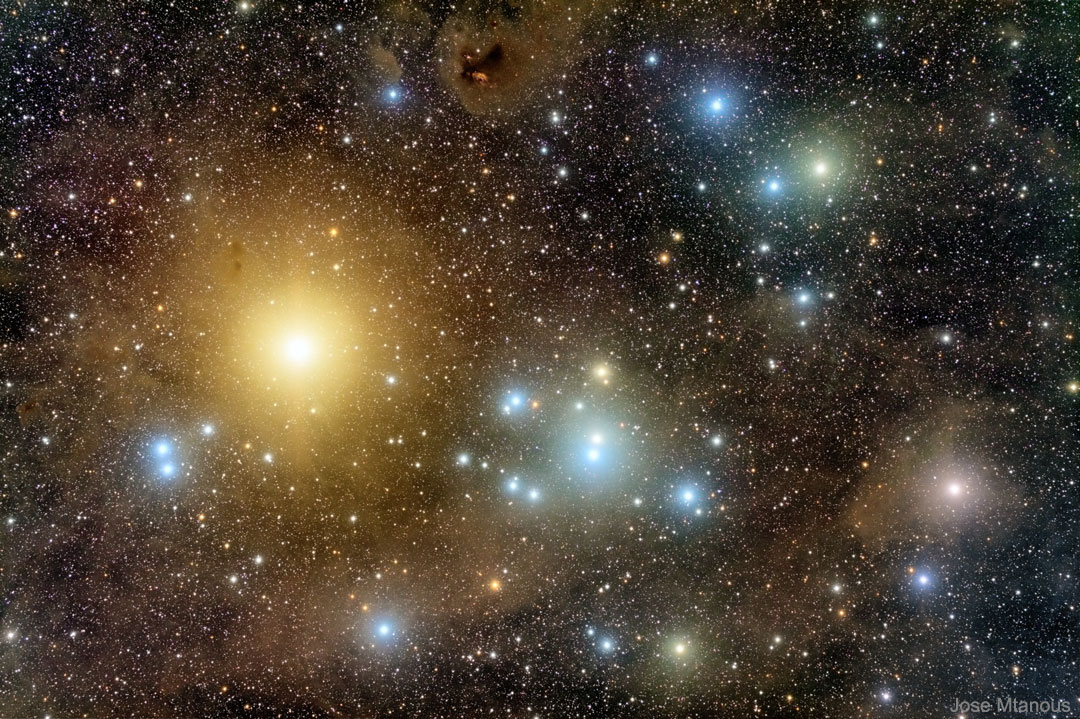The closest black holes to Earth could be in the Hyades star cluster
- New simulations support the presence of two or three black holes in a star cluster located about 150 light-years away, ten times closer than the nearest known black hole
- The simulations have been compared with real data obtained with the Gaia mission of the European Space Agency (ESA)
- The study has had the collaboration of IEEC researchers at the Institute of Cosmos Sciences (ICCUB)

Caption: Image of the Hyades star cluster.
Credits: Jose Mtanous.
A group of scientists have published new results that hint at the existence of several black holes in the Hyades cluster, making them the closest black holes to Earth ever detected (ten times closer than the nearest known black hole). The research has been published in the Monthly Notices of the Royal Astronomical Society this September.
The work, led by Stefano Torniamenti from the University of Padova, was carried out during his research stay at the Institute of Cosmos Sciences of the University of Barcelona (ICCUB), one of the research units that make up the Institute of Space Studies of Catalonia (IEEC — Institut d’Estudis Espacials de Catalunya), where he collaborated with Mark Gieles (ICREA research professor at ICCUB-IEEC) and Friedrich Anders (ICCUB-IEEC).
Since their discovery, black holes have been one of the most mysterious and fascinating phenomena in our Universe, becoming an object of study for researchers all over the world. This is particularly true for small black holes, because they have been the most observed during the detection of gravitational waves. Since the detection of the first gravitational waves in 2015, many events which correspond to mergers of pairs of lower-mass black holes have been observed.
In the newly published paper, the team of astrophysicists use simulations that reproduce the motion and evolution of all the stars of the Hyades, which is the closest open cluster to our Solar System (its distance to the Sun is approximately 150 light years). Open clusters are loosely bound groups of hundreds of stars that share some properties such as their age and chemical characteristics. The results of the simulation were then compared to the actual position and velocities of the Hyades stars, which are now accurately known thanks to the observations made by the Gaia Satellite of the European Space Agency (ESA).
“Our simulations can only simultaneously match the mass and size of the Hyades if some black holes are present at the cluster centre at the present day (or until recently),” says Stefano Torniamenti, now postdoctoral researcher at the University of Padova and first author of the paper. The work was done during a research stay of Torniamenti at the ICCUB and it is the result of the close collaboration of this institute with the University of Padova, the University of Cambridge (UK), the European Southern Observatory (ESO) and Sun Yat-sen University (China).
The Hyades observed properties are best reproduced by simulations with 2 or 3 black holes at present. However, the simulations where all the black holes were recently ejected (less than 150 million years ago, roughly the last quarter of the age of the cluster) can still give a good match because the cluster’s evolution could not erase the imprints of its previous black hole population.
In any case, the new results indicate that the black holes born in the Hyades are still inside the cluster, or very near. This makes them the closest black holes to the Sun, much closer than the prior candidate, namely Gaia BH1, which is at 1570 light-years from the Sun.
“This observation helps us to understand how the presence of black holes affects the evolution of star clusters and how in turn star clusters contribute to the gravitational wave sources”, comments Gieles, host of the first author in Barcelona. “These results also give us a glimpse at how these mysterious objects are distributed throughout the galaxy,” concludes the researcher.
Press release prepared in collaboration with the Institute of Cosmos Sciences of the University of Barcelona (ICCUB).
More information
This research is presented in a paper entitled “Stellar-mass black holes in the Hyades star cluster?”, by S. Torniamenti, M. Gieles et al., which appeared in the journal Monthly Notices of the Royal Astronomical Society in September 2023. DOI: 10.1093/mnras/stad1925
Contacts
IEEC Communication Office
Barcelona, Spain
E-mail: comunicacio@ieec.cat
Lead Researcher at the IEEC
Barcelona, Spain
Mark Gieles
Institute of Space Studies of Catalonia (IEEC)
Institute of Cosmos Sciences (ICCUB)
E-mail: mgieles@ieec.cat
About the IEEC
The Institute of Space Studies of Catalonia (IEEC — Institut d’Estudis Espacials de Catalunya) promotes and coordinates space research and technology development in Catalonia for the benefit of society. IEEC fosters collaborations both locally and worldwide and is an efficient agent of knowledge, innovation and technology transfer. As a result of more than 25 years of high-quality research, done in collaboration with major international organisations, IEEC ranks among the best international research centres, focusing on areas such as: astrophysics, cosmology, planetary science, and Earth Observation. IEEC’s engineering division develops instrumentation for ground- and space-based projects, and has extensive experience in working with private or public organisations from the aerospace and other innovation sectors.
The IEEC is a non-profit public sector foundation that was established in February 1996. It has a Board of Trustees composed of the Generalitat de Catalunya, Universitat de Barcelona (UB), Universitat Autònoma de Barcelona (UAB), Universitat Politècnica de Catalunya · BarcelonaTech (UPC), and the Spanish Research Council (CSIC). The IEEC is also a CERCA centre.
